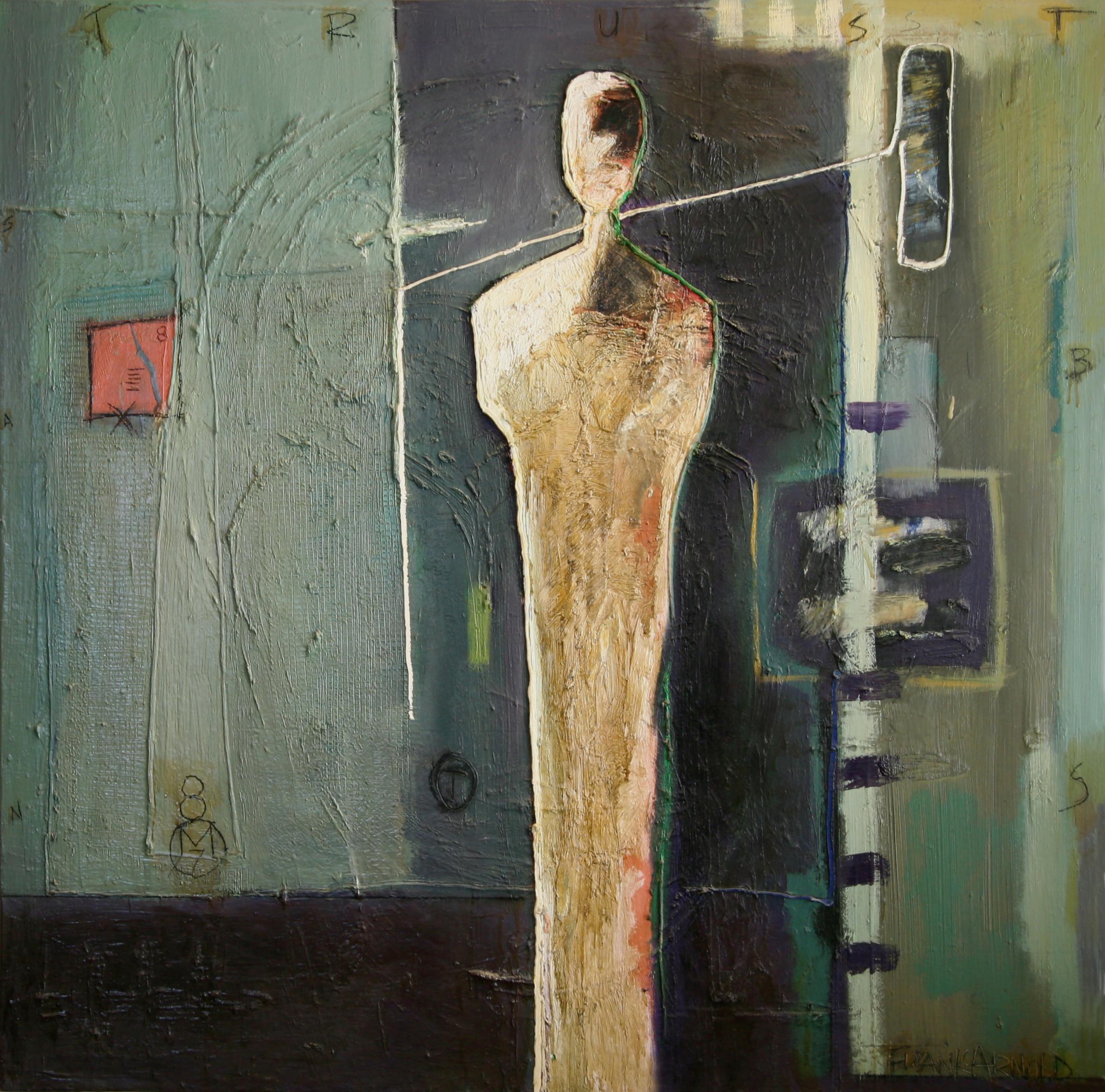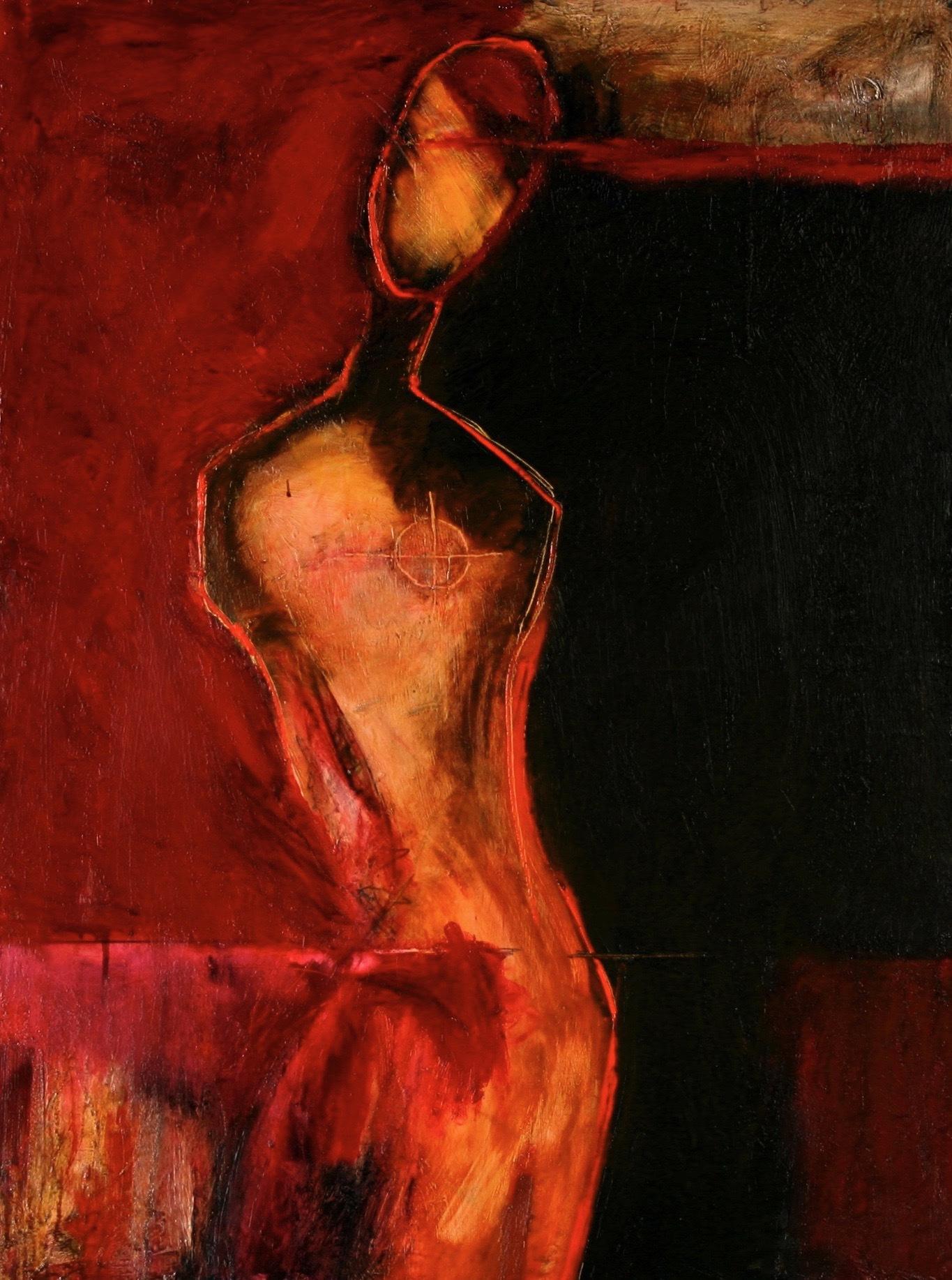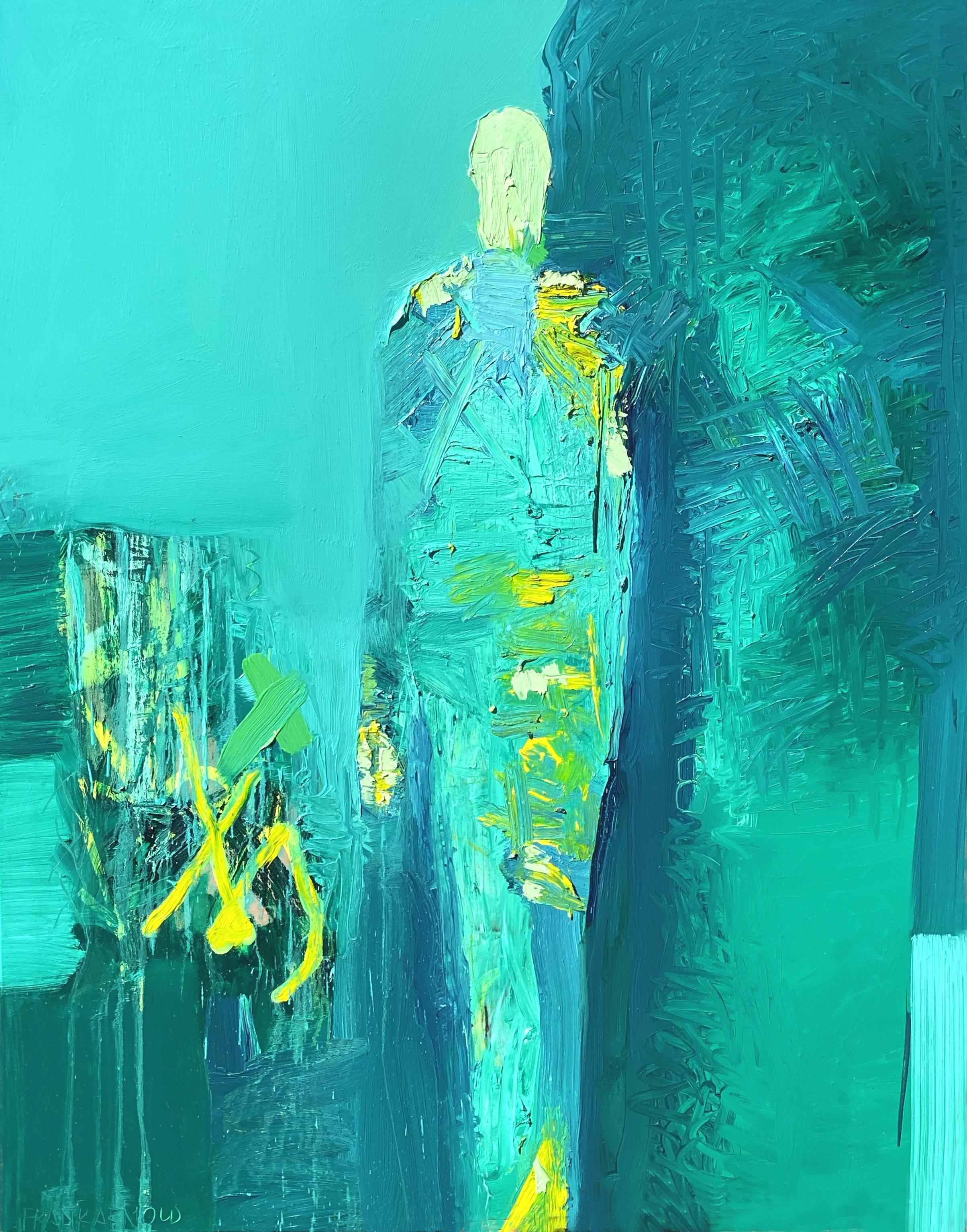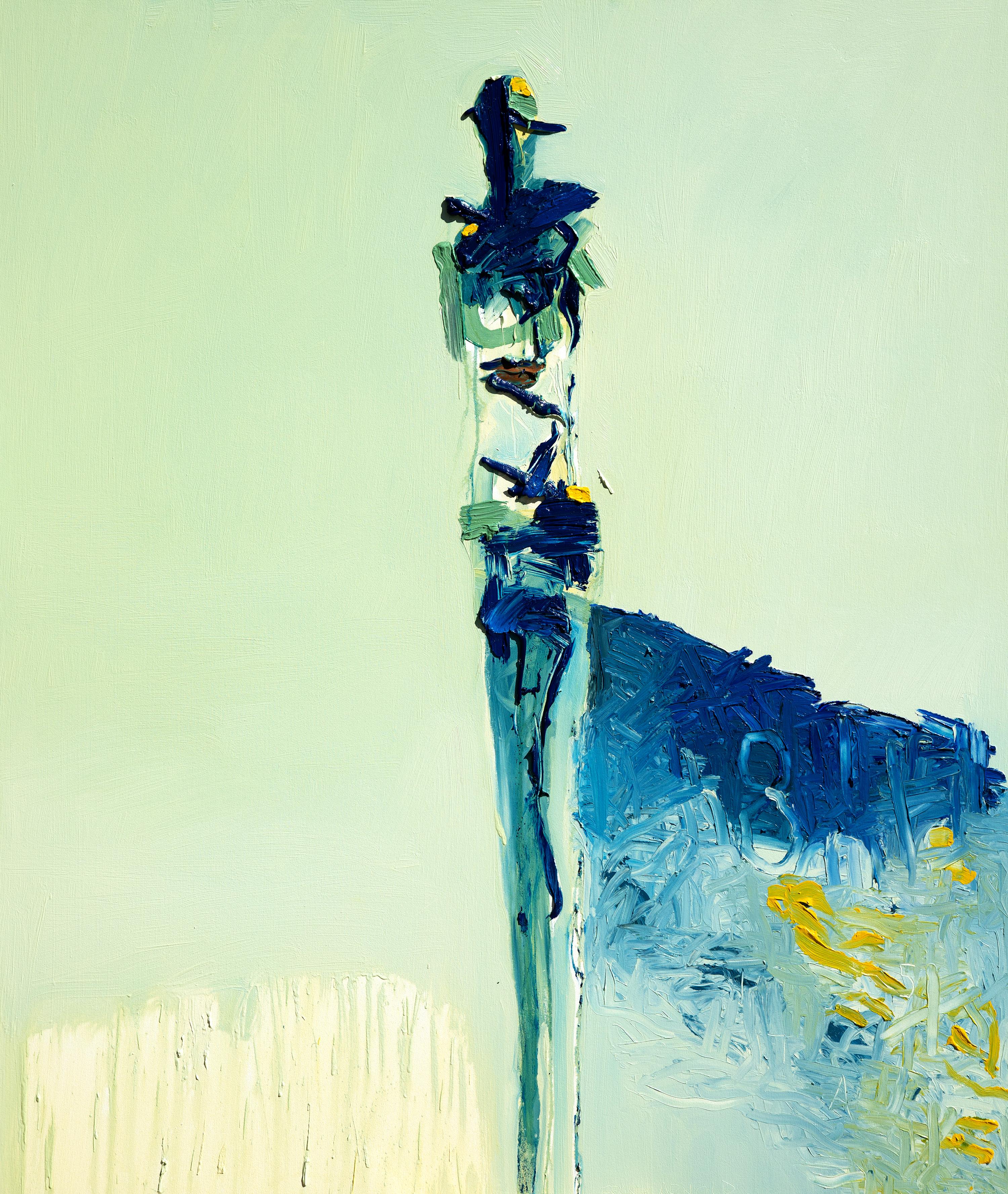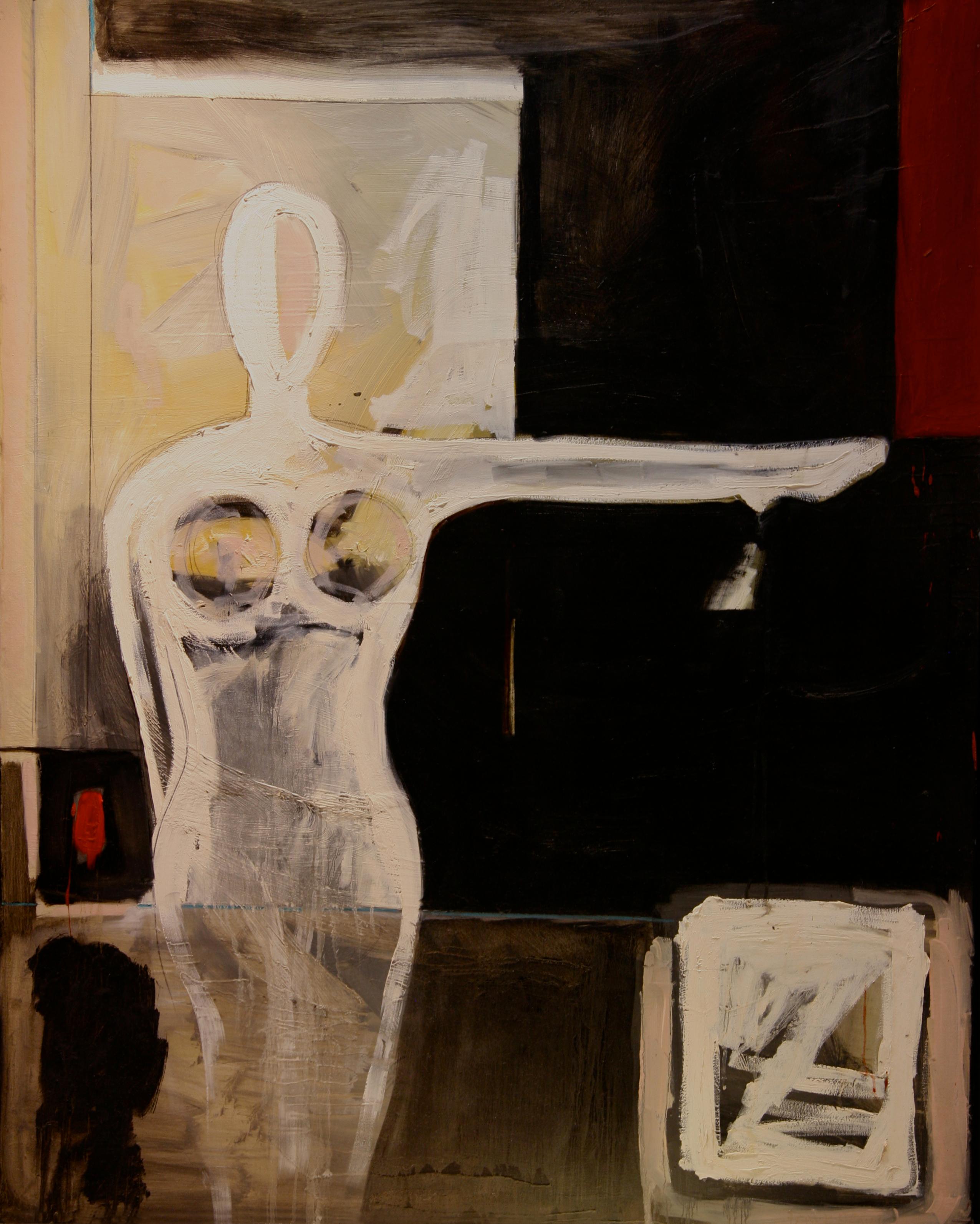Items Similar to Abstract Painting in Blue, Gray & Black, Vintage 1960s Mid Century Modern Art
Video Loading
Want more images or videos?
Request additional images or videos from the seller
1 of 15
Charles Ragland BunnellAbstract Painting in Blue, Gray & Black, Vintage 1960s Mid Century Modern Art1963
1963
About the Item
Original vintage 1960s abstract painting by 20th century Colorado Springs artist Charles Ragland Bunnell. The painting is signed by the artist and dated 1963 lower right. This midcentury modern era art work was painted in colors of blue, black, brown, gray and white. Presented in a custom black float frame, outer dimensions measure 20 ⅜ x 16 ¼ inches. Art work exclusive of the frame measures 20 x 16 inches.
Provenance: Estate of Charles Ragland Bunnell
About the artist:
Charles Ragland Bunnell developed a love for art at a very young age. As a child in Kansas City, Missouri, he spent much of his time drawing. When he was unable to find paper he drew on walls and in the margins of textbooks for which he was often fined. Around 1915, Bunnell moved with his family to Colorado Springs, Colorado. He served in World War I and later used his GI Training to study at the Broadmoor Art Academy (later renamed the Colorado Springs Fine Arts Center) during 1922 and 1923.
In 1922, he married fellow student, Laura Palmer. He studied with Ernest Lawson in 1927-1928 and, in the winter of 1928-1929, he served as Lawson’s assistant. In the late 1920’s, the Bunnell’s settled just west of Colorado Springs and 1928, they welcomed the first of their three children. Their one-acre homesite, which they referred to as “Old Home Place”, was situated between two sets of railroad tracks at the foot of Pike’s Peak. Charlie converted an old railroad boxcar into his studio, where he later gave lessons.
Beginning in 1931, Bunnell spent a year and a half studying under Boardman Robinson. The two men clashed constantly due to a generation gap and markedly different philosophies. Robinson encouraged his students not to stray from realism and though Bunnell mastered Robinson’s preferred style of American Scene painting, he regularly irritated his professor with his abstract sketches.
Bunnell taught at the Kansas City Art Institute during the summers of 1929, 1930, 1940, and 1941. Between 1934 and 1941, he painted and taught under federal projects which included assisting Frank Mechau on murals for the Colorado Springs Post Office. However, he did not take to mural making and, after criticism from Boardman Robinson about his use of “heavy daubs which have no place in mural work,” he abandoned mural-making altogether.
By the late 1930’s, Bunnell’s work departed from the American Scene/Modernist style he was trained in towards abstraction. This is marked by his “Black and Blue” series, consisting of 83 abstracted ink and watercolors. Affected by the Second World War and the loss of his 10-year old son, Bunnell’s work of the early 1940’s took on a Transcendental and Surrealist tone. The works from this period are moody and readily reflect the political and personal turmoil experienced by the artist.
In the late 1940’s, Bunnell began experimenting with Abstract Expressionism. He alone is credited with introducing Colorado Springs to the new style as it was excluded from the Fine Art Center’s curriculum by Boardman Robinson. Bunnell excelled in Abstract Expressionism and continued to evolve in the style through the 1950’s continuing to his death in 1968. He was recently recognized as a premier American Abstract Expressionist by his inclusion in the book, "American Abstract Expressionism of the 1950’s: An Illustrated Survey". ©David Cook Galleries, LLC
Solo Exhibits: Kansas City Art Institute, Kansas City, Missouri, 1930; Santa Fe Museum, Santa Fe, New Mexico, 1947; University of Illinois, Urbana, Illinois, 1948; University of Kentucky, Lexington, Kentucky, 1949; Taos Gallery, Taos, New Mexico, 1951; Carl Barnett Galleries, Dallas, Texas, 1952; The Bodley Gallery, New York, 1955; Amarillo, Texas, 1955; Haigh Gallery, Denver, Colorado, 1955; Colorado Springs Fine Arts Center, Colorado Springs, Colorado, 1956; Dord Fitz Art Gallery, Amarillo, Texas, December 1956 – February 1957, 1959, 1969 (retrospective).
Group Exhibits: Carnegie Institute, 1927-1928; Colorado State Fair, 1928 (1st prize); Artists Midwestern, Kansas City, Missouri, 1929 (Gold Medal); Art Institute of Chicago, 1947 (the exhibit traveled to ten major museums in the United States); “Artists West of the Mississippi”, Colorado Springs Fine Arts Center, Colorado Springs, Colorado (7 times); Denver Art Museum Western Annual, Denver, Colorado (5 times); Mid-America Annual, Kansas City, Missouri, 1958; First Provincetown Festival, 1958; Southwestern Annual, Santa Fe, New Mexico, Winter 1957-1958; Central City, Colorado; Cañon City, Colorado.
Further Reading: A Show of Color: 100 Years of Painting in the Pike’s Peak Region, Robert L. Shalkop, Colorado Springs Fine Arts Center, Colorado Springs, Colorado, 1971.; American Abstract Expressionism of the 1950’s: An Illustrated Survey, Marika Herskovic, Ed., New York School Press, New Jersey, 2003; Artists of the American West: A Biographical Dictionary, Vol. 1, Doris Ostrander Dawdy, Swallow Press, Chicago, 1980. 3 Vols.; Bunnell, with a foreward by Dord Fritz. Printed by Creative Press, 1970; John F. Carlson and Artists of the Broadmoor Academy, David Cook Fine Art, Denver, Colorado, 1999.; Pikes Peak Vision: The Broadmoor Art Academy, 1919-1945, Colorado Springs Fine Arts Center, Colorado Springs, Colorado, 1989.; The Illustrated Biographical Encyclopedia of Artists of the American West, Peggy and Harold Samuels, Doubleday & Company, Inc., Garden City, New York, 1976.; Who Was Who in American Art 1564-1975: 400 Years of Artists in America, Vol. 1. Peter Hastings Falk, Georgia Kuchen and Veronica Roessler, eds., Sound View Press, Madison, Connecticut, 1999. 3 Vols.
- Creator:Charles Ragland Bunnell (1897-1968, American)
- Creation Year:1963
- Dimensions:Height: 20.5 in (52.07 cm)Width: 16.25 in (41.28 cm)Depth: 1 in (2.54 cm)
- Medium:
- Movement & Style:
- Period:
- Condition:
- Gallery Location:Denver, CO
- Reference Number:
About the Seller
5.0
Platinum Seller
These expertly vetted sellers are 1stDibs' most experienced sellers and are rated highest by our customers.
Established in 1979
1stDibs seller since 2013
265 sales on 1stDibs
Typical response time: 3 hours
- ShippingRetrieving quote...Ships From: Denver, CO
- Return PolicyA return for this item may be initiated within 7 days of delivery.
More From This SellerView All
- Taos, New Mexico, 1975 Mid Century Modern Abstract Oil Painting, 52 x 40 inchesBy James MeekLocated in Denver, CO"Untitled (Taos, New Mexico)" is an abstract oil on canvas by James Meek (b. 1928) from 1975 with a rich golden-brown and stark horizontal, parallel lines in blue and orange that con...Category
1970s Abstract Abstract Paintings
MaterialsCanvas, Oil
- Light of Hope, 1970s Abstract Geometric Oil Painting Red Black and BrownLocated in Denver, CO1970s abstract oil on canvas by Broadmoor Academy artist Lawrence (Larry) Harris (1937-2008). Geometric shapes across the center of the canvas in warm colors of red, orange, yellow, black and brown. Presented in a custom wood frame measuring 20 ½ x 26 ½ inches. Image size measures 18 x 24 inches. Piece is clean and in very good condition - please contact us for a detailed condition report. Expedited and international shipping is available - please contact us for a quote. About the Artist: Lawrence Harris...Category
1970s Abstract Geometric Abstract Paintings
MaterialsCanvas, Oil
- Winter Witches in an Upside World Interfering with Each Other, Semi-Abstract OilBy Edward MarecakLocated in Denver, COOil painting on burlap by Edward Marecak (1919-1993) titled "Winter Witches in an Upside World Interfering with Each Other" from 1990. Titled and dated by the artist on verso. Painted in shades of black, gray, red, purple, and green. Presented in the original artist frame, outer dimensions measure 44 ⅛ x 44 ⅛ x 1 ⅜ inches. Image size is 43 x 43 inches. About the artist: Edward Marecak Born Ohio 1919 Died Colorado 1993 Born to immigrant parents from the Carpathian region in Slovakia, Marecak grew up with his family in the farming community of Bennett’s Corners, now part of the town of Brunswick, near Cleveland, Ohio. When he turned twelve, his family moved to a multi-ethnic neighborhood of Poles, Czechs, Slovaks, and Slovenians in Cleveland. His childhood household cherished the customs and Slavic folk tales from the Old Country that later strongly influenced his work as a professional artist. During junior high he painted scenery for puppet shows of “Peter and the Wolf,” awakening his interest in art. In his senior year in high school he did Cézanne-inspired watercolors of Ohio barns at seventy-five cents apiece for the National Youth Administration. They earned him a full scholarship to the Cleveland Institute of Art (1938-1942) where he studied with Henry George Keller whose work was included in the 1913 New York Armory Show. In 1940 Marecak also taught at the Museum School of the Cleveland Institute. Before being drafted into the military in 1942, he briefly attended the Cranbrook Academy of Art near Detroit, one of the nation’s leading graduate schools of art, architecture, and design. A center of innovative work in architecture, art and design with an educational approach built on a mentorship model, it has been home to some of the world’s most renowned designers and artists, including Eero Saarinen, Charles Eames, Daniel Libeskind and Harry Bertoia. Marecak’s studies at Cranbrook with painter Zoltan Sepeshy and sculptor Carl Milles were interrupted by U.S. army service in the Aleutian Islands during World War II. Following his military discharge, Marecak studied on the G.I. Bill at the Colorado Springs Fine Arts Center from 1946 to 1950, having previously met its director, Boardman Robinson, conducting a seminar in mural painting at the Cleveland Institute of Art. Although he did not work with Robinson at the Fine Arts Center, who had become quite ill - retiring in 1947 - he studied Robinson’s specialty of mural painting before leaving to briefly attend the Cranbrook Academy in 1947. That same year he returned to the Fine Arts Center, studying painting with Jean Charlot and Mary Chenoweth, and lithography with Lawrence Barrett with whom he produced some 132 images during 1948-49. At the Fine Arts Center he met his future wife, Donna Fortin, whom he married in 1947. Also a Midwesterner, she had taken night art courses at Hull House in Chicago, later studying at the Art Institute of Chicago with the encouragement of artist Edgar Britton. After World War II she studied with him from 1946 to 1949 at the Fine Arts Center. (He had moved to Colorado Springs to treat his tuberculosis.) Ed Marecak also became good friends with Britton, later collaborating with him on the design of large stained glass windows for a local church. In 1950-51 Marecak returned to the Cleveland Institute of Art to complete his Bachelor of Fine Arts degree. A year later he was invited to conduct a summer class at the University of Colorado in Boulder, confirming his interest in the teaching profession. In 1955 he received his teaching certificate from the University of Denver. Vance Kirkland, the head of its art department, helped him get a teaching job with the Denver Public Schools so that he and his family could remain in the Mile High City. For the next twenty-five years he taught art at Skinner, Grove, East, George Washington and Morey Junior High Schools. Prior to coming to Colorado, Marecak did watercolors resembling those of Winslow Homer, John Singer Sargent and Charles Burchfield. However, once in Colorado Springs he decided to destroy much of his earlier oeuvre, embarking on a totally new direction unlike anything he had previously done. Initially, in the 1940s, he was influenced by surrealist imagery and Paul Klee and in the West by Indian petroglyphs and Kachinas. His first one-person show at the Garrett Gallery in Colorado Springs in 1949 featured paintings and lithographs rendered in the style of Magic Realism and referential abstraction. The pieces, including an oil Witch with Pink Dish, foreshadowed the output of his entire Colorado-based career, distinguished by a dramatic use of color, intricacy of execution and attention to detail contributing to their visual impact. He once observed, “Each time I start a new painting I always fool myself by saying this time keep it simple and not get entangled with such complex patterns, color and design; but I always find myself getting more involved with richness, color and subject matter.” An idiosyncratic artist proficient in oil, acrylic, watercolor, gouache, and casein, he did not draw upon Colorado subject matter for his work, unlike many of his fellow painters in the state. Instead he used Midwest landscape imagery, bringing to life in it witches and spirits adapted from the Slovakian folk tales he heard growing up in Ohio. A number of his paintings depict winter witches derived from the Slovak custom in the Tatra Mountains of burning an effigy of the winter witch in the early spring to banish the memory of a hard winter. The folk tale element imparts a dream-like quality to many of his paintings. A devote of Greek mythology, he placed the figures of Circe, Persephone, Sybil, Hera and others in modern settings. The goddess in Persephone Brings a Pumpkin to her Mother, attired as a Midwestern farmer’s daughter, heralds the advent of fall with the pumpkin before departing to spend the winter season in the underworld. Train to Olympus, the meeting place of the gods in ancient Greece, juxtaposes ancient mythology with modernity creating a combination of whimsy and thought-provoking consideration for the viewer. Voyage to Troy #1 alludes to the ancient city that was the site of the Trojan Wars, but has a contemporary, autobiographical component referencing the harbor of the Aleutian Islands recaptured from the Japanese during World War II. In the 1980s Marecak used the goddess Hera in his painting, Hera Contemplates Aspects of the Art Nouveau, to comment on art movements in the latter half of the twentieth century Marecak’s love of classical music and opera, which he shared with his wife and to which he often listened while painting in his Denver basement studio, is reflected in Homage of Offenbach, an abstract work translating the composer’s musical colors into colorful palette. Pace, Pace, Mio Dio, the title of his earliest surrealist painting, is a soprano aria from Verdi’s opera...Category
1990s Abstract Figurative Paintings
MaterialsBurlap, Oil
- New York City Abstract Skyline, Semi Abstract Night Scene Cityscape Oil PaintingBy Charles Ragland BunnellLocated in Denver, COOil on board painting of abstracted New York City skyline by Charles Ragland Bunnell from 1951. Nocturne cityscape painted in colors of black, shades of blue, and yellow. Presented in a custom black frame, outer dimensions measure 30 ¼ x 12 ¼ x ¾ inches. Image size is 30 x 12 ¼ inches. Painting is in good vintage condition - please contact us for detailed condition report. Provenance: Estate of Charles Ragland Bunnell Expedited and international shipping is available - please contact us for a quote. About the Artist: Charles Bunnell developed a love for art at a very young age. As a child in Kansas City, Missouri, he spent much of his time drawing. When he was unable to find paper he drew on walls and in the margins of textbooks for which he was often fined. Around 1915, Bunnell moved with his family to Colorado Springs, Colorado. He served in World War I and later used his GI Training to study at the Broadmoor Art Academy (later renamed the Colorado Springs Fine Arts Center) during 1922 and 1923. In 1922, he married fellow student, Laura Palmer...Category
1950s Abstract Abstract Paintings
MaterialsOil, Board
- American Modernist Abstract Still Life Painting with Zinnia Flowers, Red OrangeLocated in Denver, COOil on board painting by Paul Kauvar Smith (1893-1977) of a still life of flowers on a table in an interior scene with a mirror in the background. American Modernist still life painting with zinnias and abstract paintings in an artists studio. Presented framed, outer dimensions measure 27 ⅝ x 31 ¾ x 1 ⅛ inches. Image size is 19 ½ x 23 ½ inches. Painting is clean and in very good vintage condition - please contact us for a detailed condition report. Provenance: Private collection, Denver, Colorado Expedited and international shipping is available - please contact us for a quote. About the Artist: In 1915, Paul Kauver Smith studied commercial art and design at the St. Louis School of Fine Art for two years. His studies were interrupted by World War I during which he served as a corporal in the U.S. Army. After the war he returned to the School of Fine Art and also studied at the Washington University School of Fine Arts in St. Louis with Fred G. Carpenter, himself a student of Jean-Paul Laurens at the Colarossi Academy in Paris. Carpenter was known as a marvelous colorist who "thought every inch of a painting should be fascinating…and should be as interesting close up as from a distance." His approach is reflected in many of Smith’s paintings, both representational and abstract in style, done later in Colorado. In 1921, Smith relocated to Denver where he studied for two years at the Denver Academy of Fine and Applied Arts, formerly located in Brinton Terrace on 18th Street in Denver’s Capitol Hill neighborhood. His teacher was John E. Thompson, another important influence as a pioneer of modernism in Denver. The Academy hired Smith as an instructor in 1923 and that same year the Denver Art Museum included his work for the first time in its 29th annual juried exhibition. He later had two solo shows at the museum, which added his work to its Anne Evans Collection. In 1959 the museum reproduced Houses at Victor, for its Western Heritage Exhibition catalog. During the year of 1928 he witnessed the Articles of Incorporation of the Denver Artists Guild, comprising most of the city’s professional artists. He also belonged to the American Artists Professional League, also organized in 1928 by fifteen members of the Salmagundi Club in New York to protect artists’ interest and promote traditional American art. He was one of some two dozen Colorado artists designated to participate in the Public Works of Art Program (PWAP, 1933-34), the first federally-sponsored program for artists during the Great Depression. Around 1928 Smith became the "Hermit of Stuart Street," and remained a life-long bachelor. One painting, View from My Window, depicts his immediate neighborhood. Living for more than thirty years at 1039 Stuart Street in West Denver, he gave up creature comforts that most people take for granted to have the freedom to devote his life to the pursuit of art. In the first twenty-five years of his career, his paintings focused on the Colorado landscape and its mining towns with their decaying buildings as relics of the past. His piece, Miner’s House at Victor, Colorado illustrates the description of his work in this genre as described by Denver artist and art writer, Arneill Downs, "The jewel-like shapes and colors the artist uses gives the most decrepit objects style. The decaying buildings of ghost towns, grouped together on canvas, glow like a patchwork quilt." Smith described his technique as "I start lean and finish fat." He worked first with turpentine as a medium and ended up with pure pigment put on with a palette knife. In addition to Colorado scenes...Category
20th Century Abstract Still-life Paintings
MaterialsOil, Board
- The Argument, 1960s Vintage Semi-Abstract Oil Painting in Reds, Pinks, and BlackBy Edward MarecakLocated in Denver, COOil on board painting by Edward Marecak (1919-1993) titled "The Argument" from 1968. Semi-abstract oil painting depicting two figures in colors of greens, pinks, blues, and blacks. Presented framed, outer dimensions measure 49 ½ x 33 ¼ x 1 ½ inches. Image size is 48 x 32 inches. Painting is clean and in very good vintage condition - please contact us for a detailed condition report. About the artist: Born to immigrant parents from the Carpathian region in Slovakia, Marecak grew up with his family in the farming community of Bennett’s Corners, now part of the town of Brunswick, near Cleveland, Ohio. When he turned twelve, his family moved to a multi-ethnic neighborhood of Poles, Czechs, Slovaks, and Slovenians in Cleveland. His childhood household cherished the customs and Slavic folk tales from the Old Country that later strongly influenced his work as a professional artist. During junior high he painted scenery for puppet shows of “Peter and the Wolf,” awakening his interest in art. In his senior year in high school he did Cézanne-inspired watercolors of Ohio barns at seventy-five cents apiece for the National Youth Administration. They earned him a full scholarship to the Cleveland Institute of Art (1938-1942) where he studied with Henry George Keller whose work was included in the 1913 New York Armory Show. In 1940 Marecak also taught at the Museum School of the Cleveland Institute. Before being drafted into the military in 1942, he briefly attended the Cranbrook Academy of Art near Detroit, one of the nation’s leading graduate schools of art, architecture, and design. A center of innovative work in architecture, art and design with an educational approach built on a mentorship model, it has been home to some of the world’s most renowned designers and artists, including Eero Saarinen, Charles Eames, Daniel Libeskind and Harry Bertoia. Marecak’s studies at Cranbrook with painter Zoltan Sepeshy and sculptor Carl Milles were interrupted by U.S. army service in the Aleutian Islands during World War II. Following his military discharge, Marecak studied on the G.I. Bill at the Colorado Springs Fine Arts Center from 1946 to 1950, having previously met its director, Boardman Robinson, conducting a seminar in mural painting at the Cleveland Institute of Art. Although he did not work with Robinson at the Fine Arts Center, who had become quite ill - retiring in 1947 - he studied Robinson’s specialty of mural painting before leaving to briefly attend the Cranbrook Academy in 1947. That same year he returned to the Fine Arts Center, studying painting with Jean Charlot and Mary Chenoweth, and lithography with Lawrence Barrett with whom he produced some 132 images during 1948-49. At the Fine Arts Center he met his future wife, Donna Fortin, whom he married in 1947. Also a Midwesterner, she had taken night art courses at Hull House in Chicago, later studying at the Art Institute of Chicago with the encouragement of artist Edgar Britton. After World War II she studied with him from 1946 to 1949 at the Fine Arts Center. (He had moved to Colorado Springs to treat his tuberculosis.) Ed Marecak also became good friends with Britton, later collaborating with him on the design of large stained glass windows for a local church. In 1950-51 Marecak returned to the Cleveland Institute of Art to complete his Bachelor of Fine Arts degree. A year later he was invited to conduct a summer class at the University of Colorado in Boulder, confirming his interest in the teaching profession. In 1955 he received his teaching certificate from the University of Denver. Vance Kirkland, the head of its art department, helped him get a teaching job with the Denver Public Schools so that he and his family could remain in the Mile High City. For the next twenty-five years he taught art at Skinner, Grove, East, George Washington and Morey Junior High Schools. Prior to coming to Colorado, Marecak did watercolors resembling those of Winslow Homer, John Singer Sargent and Charles Burchfield. However, once in Colorado Springs he decided to destroy much of his earlier oeuvre, embarking on a totally new direction unlike anything he had previously done. Initially, in the 1940s, he was influenced by surrealist imagery and Paul Klee and in the West by Indian petroglyphs and Kachinas. His first one-person show at the Garrett Gallery in Colorado Springs in 1949 featured paintings and lithographs rendered in the style of Magic Realism and referential abstraction. The pieces, including an oil Witch with Pink Dish...Category
1960s Abstract Abstract Paintings
MaterialsOil
You May Also Like
- Oil on Canvas “BS Trust”By Frank ArnoldLocated in Fresno, CA“BS Trust” is 36” x 36”. Frank Arnold’s paintings exhibit the highest quality materials for a truly archival piece, created to last generations. Much of Frank Arnold’s work is sourc...Category
2010s Abstract Abstract Paintings
MaterialsCanvas, Oil
- Last DanceBy Frank ArnoldLocated in Fresno, CALast Dance is an Oil on Canvas painting in soft, light aqua tones with red/brown accents. Frank Arnold is thought by many to be one of the foremost abstract...Category
2010s Abstract Abstract Paintings
MaterialsCanvas, Oil
- My Other SideBy Frank ArnoldLocated in Fresno, CA“My Other Side” is 48”x 36”. This is an earlier piece by Arnold from the estate of a late collector of his work. This piece is predominantly shades of red from light to almost black....Category
Early 2000s Abstract Abstract Paintings
MaterialsCanvas, Oil
- Oil on Canvas “2X8” by abstract-figurative artist, Frank ArnoldBy Frank ArnoldLocated in Fresno, CA"2X8" is 60” x 48”. The yellows, greens, aquas and blues are combined in the heavy hand, brush and knife strokes which characterize much of this artist’s work. Frank Arnold’s paintin...Category
2010s Abstract Abstract Paintings
MaterialsOil
- New MoveBy Frank ArnoldLocated in Fresno, CA"New Move 8" Oil on Canvas is a mix of blues and greens with chrome yellow accents. Frank Arnold is thought by many to be one of the foremost abstract figurative painters and sculpto...Category
2010s Abstract Abstract Paintings
MaterialsCanvas, Oil
- Oil on Canvas “Blake’s Wish”By Frank ArnoldLocated in Fresno, CA"Blake’s Wish" is 60” x 48”. Solo female figure Dominant colors are black, white and deep crimson red.. Frank Arnold’s paintings exhibit the highest quality materials for a truly arc...Category
2010s Abstract Abstract Paintings
MaterialsCanvas, Oil
Recently Viewed
View AllMore Ways To Browse
Mid Century Modern Painting Black
Black Blue 1960s
Abstract Mid Century Wall Art
Gold Blue Black Modern
Mid Century Modern Abstract Oil
Mid Century Modern Abstract Oil Paintings
Charles White Artist
Blue Painting Mid Century Modern
Mid Century Modern Art Purple
Old Master Paintings War
Charles 1st
1963 Abstract On Paper
Charles The 1st
Black And White Painting Mid Century Modern
Vintage F1 Art
Post Modern 1930s
1970s Abstract Modernist
Mexico City Mid Century Modern
